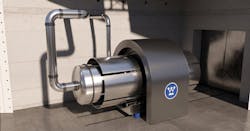Westinghouse eVinci Microreactor Could Yield 5 MW of Nuclear Power Every 8 Years for AI Data Centers
There are a number of advanced nuclear reactor technologies sitting just over the horizon, many with plans to offer operational power by the early 2030s. But full-scale small modular reactors (SMR) that offer 50-300 megawatts (MW) of onsite power generation aren’t the only possibilities that the data center industry should be following.
The potential of microreactor solutions as clean on-site backup power and supplemental power sources for other renewable technologies such as solar and wind can potentially make those more traditional renewables a better solution for data center power. Nano Nuclear Energy Inc. is one such technology provider whom DCF has been tracking, and who has made great strides this year in advancing microreactor tecnology prospects for data center onsite powering.
For its part, in September, Westinghouse announced it submitted its eVinci Microreactor Preliminary Safety Design Report (PSDR) to the Department of Energy’s (DOE) National Reactor Innovation Center (NRIC). Westinghouse is the first reactor developer to reach this milestone, in support of siting its test reactor at NRIC’s Demonstration of Microreactor Experiments (DOME) test bed at Idaho National Laboratory (INL).
Westinghouse notes the move advances the eVinci microreactor's testing for the commercial market, including data centers. NRIC is a DOE national program to accelerate the development and deployment of advanced nuclear technologies like the eVinci microreactor. Its objective is to create four new experimental facilities and two large reactor test beds by 2028 for comprehensive technology demonstrations and experiments, and to finalize two advanced nuclear technology experiments by 2030.
The Westinghouse eVinci design was one of three designs that were part of a $3.9 million federal grant in October 2023. Westinghouse, along with Radiant and Ultra Safe Nuclear Corporation, got the funding to push their designs through DOE's front-end engineering and experiment design (FEEED) process.
FEEED is there to support developers in planning for the design, fabrication, construction, and testing of fueled reactor experiments. Both Radiant and Ultra Safe Nuclear Corporation are tracking to complete FEEED by the end of 2024.
According to Jon Ball, President of eVinci Technologies at Westinghouse:
“Completing the FEEED process marks a critical step to bringing the Westinghouse eVinci Microreactor to commercial operation. We are targeting deployment of multiple eVinci microreactors across the world by the end of the decade, and the strong and continued partnership with NRIC, INL, and the Department of Energy is instrumental to our efforts.”
The reactor will be testing at the DOME test bed at the INL, repurposing the Experimental-Breeder Reactor-II containment structure, lessening the environmental footprint, minimizing expense, and reducing overall project risk.
Unrelated to the microreactor projects, the EBR II technology is what Oklo, the California-based nuclear fission startup backed by OpenAI founder and CEO Sam Altman, on track to manufacture SMR technology for data center and industrial energy generation, is using for their reactor's development.
Nuclear Microreactor Upsides
Microreactors are much smaller than conventional nuclear power plants and produce from 200 kilowatts to 5 megawatts of electricity or heat. While this is a relatively low output, it can be used for dedicated applications such as supporting off-grid market communities, remote stand-alone industrial sites or supporting existing grid systems.
As an addition to a data center’s dedicated microgrid, microreactors can replace diesel backup generators, charge battery storage systems, and supplement power being provided from either collocated renewables or the grid.
Westinghouse sees the eVinci reactor as a clean source of continuous power, well-suited to serve this diverse range of needs. While its function is similar to current nuclear reactor technology, but on a smaller scale, the required plant maintenance and fuel would be one-tenth the frequency currently required for many existing power sources.
The eVinci 5 MW reactor core is designed to run for no less than 8 years, at full power, before requiring refueling. Most current nuclear reactor power generation stations are refueled annually.
Design and Key Features
The core of the eVinci microreactor is a solid-state heat pipe-cooled reactor, which incorporates advanced nuclear technologies, resulting in a highly miniaturized and transportable source of nuclear power.
The core design incorporates multiple heat pipes which move heat from the reactor core to the power generation system. This design is adapted from space reactor development where heat pipes have been used as a proven, high-efficiency means of moving hot ions to a colder surface with very low energy.
The design's drag has been limited by minimal moving parts, which reduces the probability of this component to fail. Westinghouse has a companion project developing a low-powered reactor with a 10 year life span for satellite and lunar power solutions, the AstroVinci Microreactor.
What is perhaps most important for many of the applications where a microreactor could provide or supplement power is the fact that the design is entirely modular, and could be shipped in components on trucks or in shipping containers, meaning the entire reactor could be set up on site much like other power generation systems.
Westinghouse says that with the final design, which it compares to battery technologies, the entire microreactor could be setup on under 2 acres.
Safety First
The microreactor itself is passively safe by design and uses the laws of physics to stay safe. If anything fails, the reactor shuts down and the heat can be safely dissipated without power or human intervention, which makes it the safest nuclear power technology on the market.
Since the reactor has passive safety features, if an emergency occurs, it is possible to put the reactor into a stable, non-radiative state without the need for human intervention. Because a large proportion of reactors’ risks are associated with human error, this suggests eVinci will have a much better safety record than traditional nuclear power generation.
Once operational, and requiring minimal onsite maintenance, the microreactor can operate for at least 8 years before it needs refueling, minimizing the management of fuel supply chains and operational disruption. In fact, once the initial fuel is spent, the reactor can be replaced with a new unit or refueled on-site and re-deployed without disrupting power supply.
Nuclear reactors, regardless of the scale, need to meet stringent requirements, and licensing can be a very lengthy and expensive process. But if any factor would stand in the way of getting microreactors off the ground, it’s probably the regulatory hurdle.
Westinghouse has already been talking to regulators about design features with the goal of making the eVinci reactor safe, but it can still take months or years to go through all these processes, both before and after initial deployment.
Replacing Diesel Power Generation
Diesel generators are often the primary source of power for mining operations in remote or rural areas, as well as the backup power for most data centers. In operation they emit large volumes of greenhouse gases, are expensive, and can be noisy, requiring significant investment in sound moderation.
The Westinghouse eVinci reactor provides the same amount of energy with zero emissions and lower costs than diesel for industrial and mining operations.
The microreactor can also act as back-up to renewable energy systems, offering the ability to have consistent baseload power generation on a renewably-driven microgrid. Due to the intermittency of wind and solar generation, the eVinci reactor acts as baseload power supplementing the carbon-free energy delivery.
Meeting Tomorrow's Data Center Power Challenges
Although the eVinci reactor is safe, and harnesses energy through passive safety features, it still produces nuclear energy. Persistent public concerns over nuclear energy will likely be a determining concern over whether even a small microreactor can be used as the primary backup power or grid supplement for a data center.
Nevertheless, as a versatile, safe, zero carbon-emitting power source, microreactors show a way forward for nuclear, with potential applications in a range of environments. They represent a potentially game-changing solution to current global challenges of universal access to clean energy, reducing carbon emissions and providing reliable power.
The Westinghouse eVinci microreactor developments come not a moment too soon for the power-thirsty data center industry in the age of AI -- for instance, in US localities such as Texas, which has become a focal point for AI power growth. To wit, according to Bloomberg reporting, last week the head of the state's Public Utility Commission said that, going forward, data center developers will need to supply some of their own power if they want to connect to the Texas grid within 12 to 15 months.
About the Author

David Chernicoff
Matt Vincent
A B2B technology journalist and editor with more than two decades of experience, Matt Vincent is Editor in Chief of Data Center Frontier.



